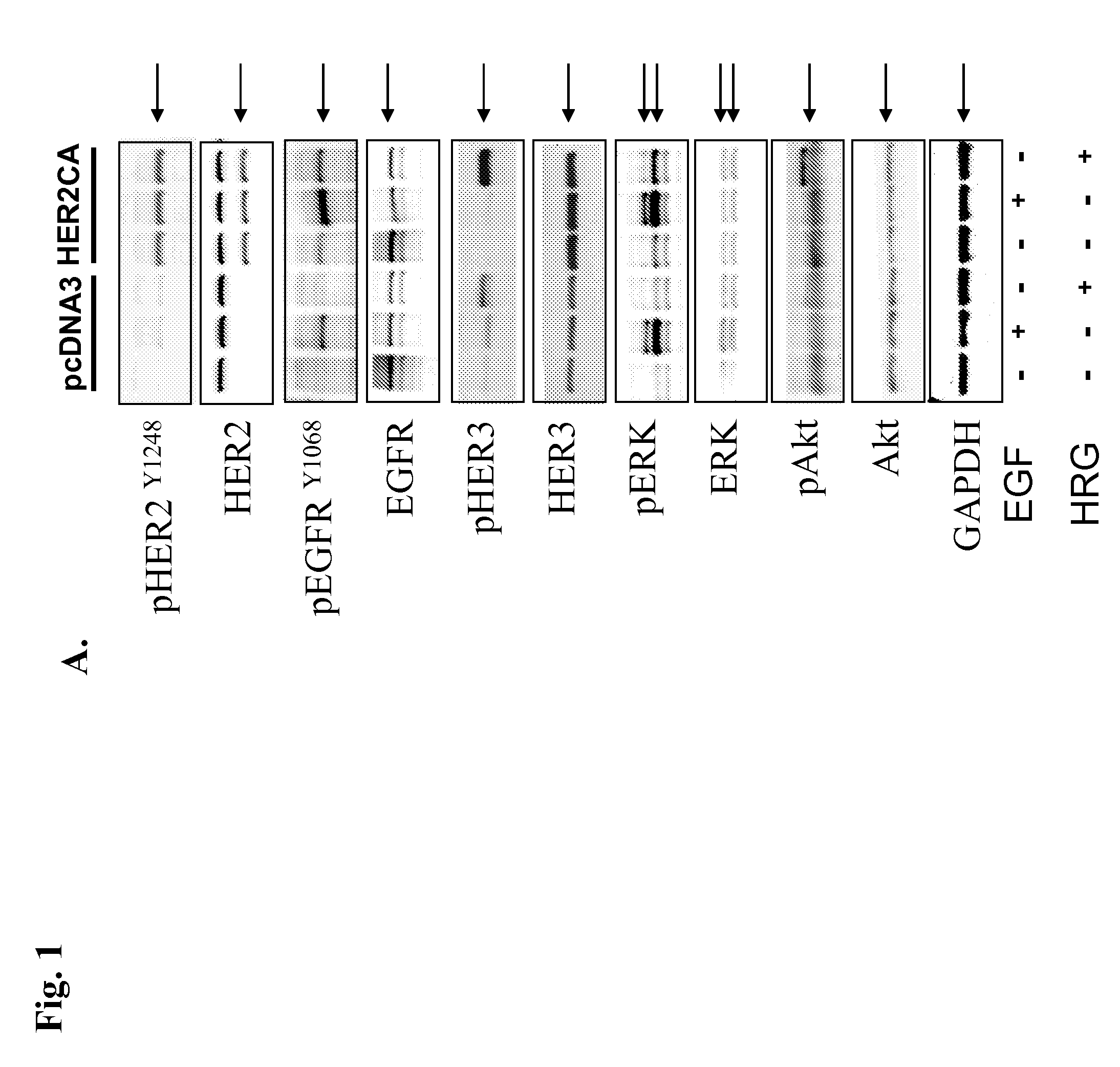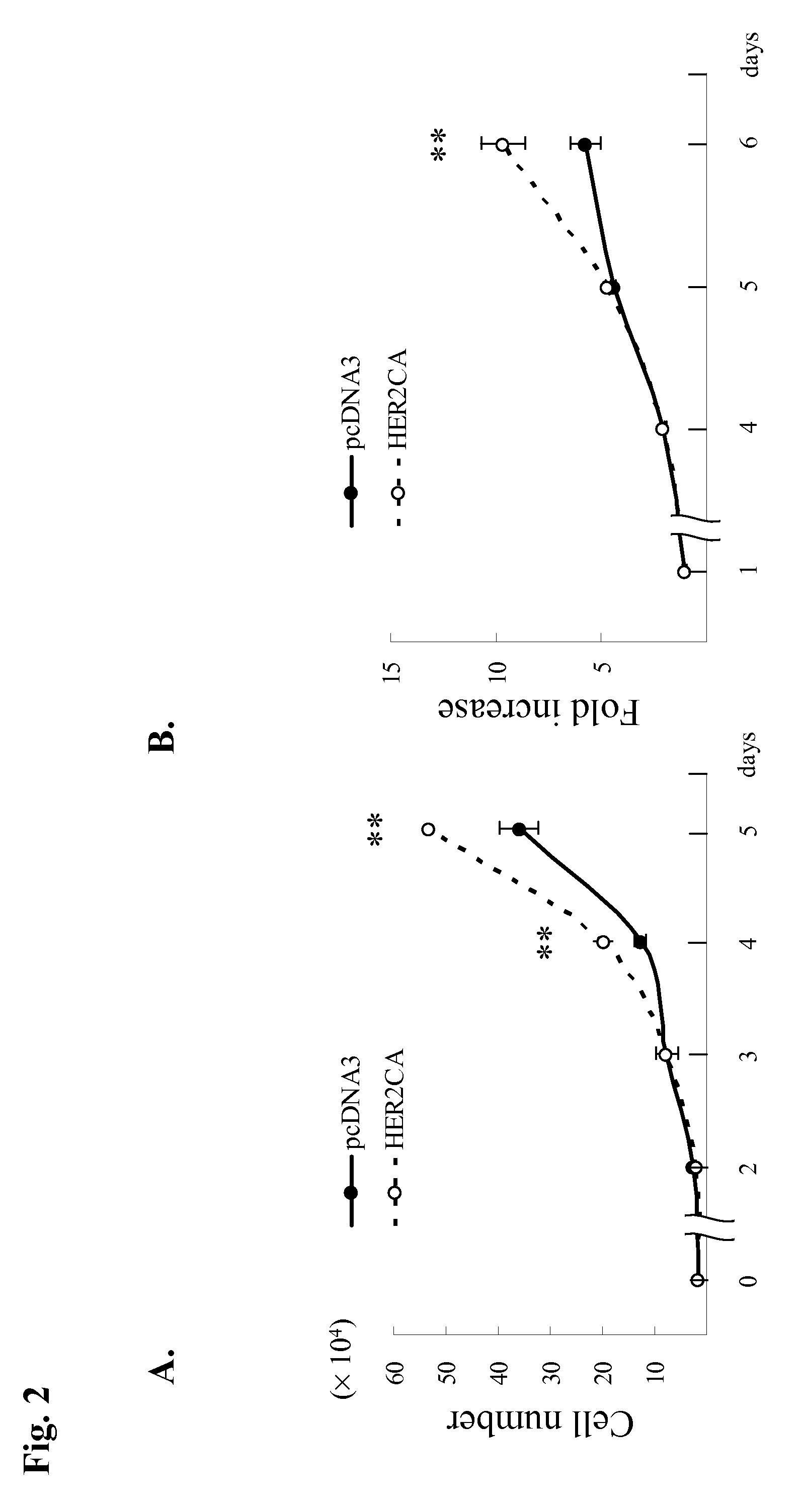Use of tyrosine kinase inhibitors for treatment of prolactinoma
a technology of tyrosine kinase inhibitors and prolactinoma, which is applied in the field of treatment of prolactinoma with tyrosine kinase inhibitors, can solve the problems of poor surgical cure rate for patients with invasive macroprolactinomas, limited dopamine agonist drug treatment, etc., to promote prolactinoma prophylaxis, inhibit and/or reduce prolactinoma, promote the effect o
- Summary
- Abstract
- Description
- Claims
- Application Information
AI Technical Summary
Benefits of technology
Problems solved by technology
Method used
Image
Examples
example 1
[0059]DMEM / F12 (phenol red free), and penicillin / streptomycin were purchased from Invitrogen. EGF was from Sigma, and NRG1-β1 / HRG1-β1 was from R&D systems. Lapatinib (Tykarb) was from LC Laboratories and gefitinib (Iressa) was purchased from Biaffin GmbH & Co. U0126 was purchased from Promega.
Stable Transfected Cells
[0060]GH3 rat lacto-somatotroph tumor cells secreting PRL and GH were purchased from the American Type Culture Collection. HER2CA cells were generated by transfection with pcDNA3-HER2CA (V654E) purchased from Addgene (Addgene plasmid 16259). Stable colonies were selected in the presence of 500 μg / ml G418 (Invitrogen). A vector control cell line pcDNA3 was simultaneously established by transfecting pcDNA3 that lacked inserted cDNA. After selection and propagation of stable transfectants, cells were cultured in DMEM / F12 medium containing 15% horse serum, 2.5% FBS, penicillin / streptomycin, and 500 μg / m G418. After synchronization by serum starvation (med...
example 2
[0072]The inventors recently reported pathways underlying in vitro and in vivo regulation of pituitary tumor gene expression and cell proliferation by EGF, heregulin and ErbB receptor ligand signaling. As Her2 / Neu, an ErbB receptor family member, is overexpressed in prolactinomas, the inventors tested the role of Her2 / Neu in prolactinoma hormone regulation and cell proliferation to support the rationale for targeting this receptor for drug therapy of those tumors.
[0073]The inventors generated constitutively active Her2 / Neu stable GH3 cell transfectants (Her2CA-GH3), and tested PRL gene expression, and cell proliferation. They inoculated hormone-secreting Her2CA-GH3 cells to WF rats, and treated them with oral lapatinib, a dual tyrosine kinase inhibitor of Herl / EGFR and Her2 / Neu, or gefitinib, a tyrosine kinase inhibitor of Herl / EGFR. They also treated primary cultured pituitary cells derived from human prolactinomas with lapatinib.
[0074]After selection and propagation, MAPK phosphor...
example 3
HER2 / ErbB2 Overexpression Enhances PRL Expression and Secretion and Cell Proliferation
[0077]GH3 rat lactosomatotroph pituitary tumor cells (GH3) were stably transfected with an expression vector containing the constitutively active form (V654E) of HER2 / ErbB2 cDNA (HER2CA) or empty vector (pcDNA3). Western blot results showed that HER2 and phosphor-HER2 protein were induced approximately 10-fold in HER2CA transfectants (FIG. 1A). Cells expressing HER2CA also contained higher levels of phosphorylated EGFR, MAPK, and Akt, but less phospho-HER3 than pcDNA3 transfectants (FIG. 1A). EGF induction of both phosphorylated EGFR and MAPK, and HRG induction of both phosphorylated HER3 and Akt, was also enhanced in HER2CA cells (FIG. 1A). HER2CA cells exhibited a marked and selective induction (˜250 fold) of PRL mRNA (P<0.0001), with no observed effects on GH mRNA expression (FIG. 1B). PRL, but not GH, secretion into the HER2CA cell medium was enhanced about 100-fold (FIG. 1C). As shown previous...
PUM
| Property | Measurement | Unit |
|---|---|---|
| wavelength | aaaaa | aaaaa |
| volume | aaaaa | aaaaa |
| volume | aaaaa | aaaaa |
Abstract
Description
Claims
Application Information
 Login to View More
Login to View More - R&D
- Intellectual Property
- Life Sciences
- Materials
- Tech Scout
- Unparalleled Data Quality
- Higher Quality Content
- 60% Fewer Hallucinations
Browse by: Latest US Patents, China's latest patents, Technical Efficacy Thesaurus, Application Domain, Technology Topic, Popular Technical Reports.
© 2025 PatSnap. All rights reserved.Legal|Privacy policy|Modern Slavery Act Transparency Statement|Sitemap|About US| Contact US: help@patsnap.com



